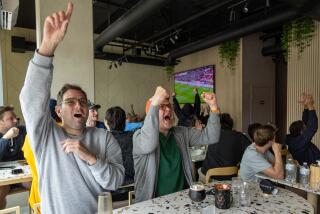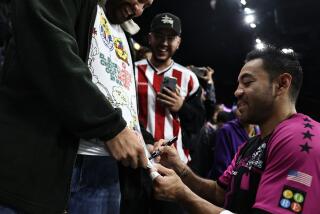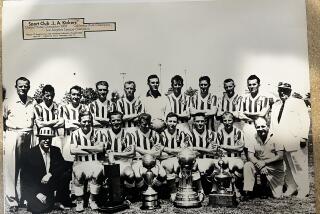Time eases futbol rivalry
Joel Aceves and I were born and raised in Los Angeles. Both of us are sons of Latin American immigrants.
But on Wednesday, we’ll be on opposite sides of a rivalry that divides a big chunk of Southern California between supporters of the green, white and red, and supporters of the red, white and blue.
It’s the biggest L.A. sports obsession you’ve never heard of -- unless you tune in to Spanish-language media, or follow that strange game in which men in shorts kick around a ball for 90 minutes.
The current rivalry between the national soccer teams of the United States and Mexico was born in Los Angeles, on a July night in 1991. Now the two teams can’t play each other here anymore because crowds got too big, and the fans too passionate.
“I don’t hate you or your team,” Joel told me as we talked in his home in South-Central. “But I’m still angry that we lost to you in 2002. I’ll never get over that.”
When we were both younger men, we traveled across Los Angeles to see our teams play.
Joel, now 32, walked across South Los Angeles to see his heroes, la seleccion de Mexico, at the Los Angeles Memorial Coliseum. I drove to the same stadium from South Whittier to watch my heroes, the national team of the United States of America.
When the two teams take to the field Wednesday night, in a qualifying match for the 2010 World Cup, it will be in the cold of Columbus, Ohio, in a 22,500-seat stadium more appropriate for a high-school football game.
Much of L.A. will be there in spirit. Some, like Angel Soto, will be there in person. The son of Guatemalan immigrants and a resident of Rancho Cucamonga, Soto, 18, likely will have to brave some very un-Californian freezing temperatures.
“I’ve got four U.S. jerseys,” Angel told me. “And I’m going to be wearing all four of them at the game.”
The match could have been played, as it once was, at the Los Angeles Memorial Coliseum or the Rose Bowl -- before 90,000 or so people like me, Joel and Angel willing to pay exorbitant prices even for nosebleed tickets.
It won’t be, because the United States Soccer Federation, which manages the U.S. National Team, long ago concluded that Mexico fans would outnumber U.S. fans at any venue in greater Los Angeles. Or, for that matter, anywhere else in California, or in the Southwest or even in New York or Chicago.
The L.A. incarnation of the rivalry reached its peak in 1998, when the United States and Mexico played for the championship of North and Central America before a Coliseum crowd of 91,255. About 70,000 of those fans, by most estimates, were there to back Mexico.
The Mexican fans made so much noise, they drowned out both national anthems. A few boors pelted the U.S. players with cups of beer.
The sight of an American stadium filled with fans waving Mexican flags and rooting against a U.S. team caused more than a few patriotic grumblings. Political scientist Samuel P. Huntington called the Mexican fans’ behavior a symptom of our “crisis of national identity” and a “dramatic rejection” by Mexican immigrants of the United States of America.
It was the last competitive match between the national teams ever played in Los Angeles.
I shared Huntington’s views with my new friend and fellow soccer aficionado, Joel Aceves. He squinted at me with puzzlement, then said, “I think I read somewhere that Americans have freedom of choice.”Joel learned to root for Mexican soccer teams growing up in South-Central in the 1990s. His father and grandfather were from Jalisco, Mexico, and die-hard fans of the Chivas of Guadalajara.
In those days, there was no domestic U.S. soccer league and thus no local team to root for.
“It was sort of predetermined that I would be a Chivas fan,” he said. “I had never heard of the U.S. team. They were never on TV.”
Mexican soccer was on Univision every weekend. And both Chivas of Guadalajara and the Mexican National Team often played exhibition games at the Coliseum.
On game days, Joel walked to the Coliseum with thousands of other fans through the lively and timeworn neighborhoods of South-Central. The laughter, the smell of hot dogs wrapped in bacon sizzling on vendors’ grills and the gray glow of the Coliseum lights are among the happiest memories of his tough L.A. childhood.
“As you got closer to the stadium, the noise got more intense,” he said. “It was like nothing I had ever experienced before.”
I’m a bit older than Joel, and my entry into soccer fandom was different. In the 1970s, long before cable TV and the Internet, I became a fan of the U.S. team because I liked to read. My dad, a Guatemalan immigrant, hated all sports and I was an oddball kid who subscribed to every American soccer magazine in circulation.
Sightings of my team on television were rarer than glimpses of Bigfoot. In 1979, when the U.S. team toured Europe, I learned the results by reading the 5 1/2 -point agate in the back of The Times’ sports pages. A week or so after the tour had ended, a couple of magazines arrived in my South Whittier mailbox with all the precious details.
“You have your merit badges as a fan,” Joel told me after I described my early suffering. “When you follow a team that has a small following, that makes you more of a fan.”
Yes, we U.S. fans were once a group so small, you almost could call us a cult.
In 1991, when Mexico and the United States played at the Coliseum in the semifinals of the first championship of North and Central America, I went alone. There were 40,000 people there that night, but I think only a few hundred or so were rooting for the United States.
The United States hadn’t beaten Mexico in a meaningful match since 1934. They won that July night 2-0, in a sporting miracle that remains the greatest night of my life as a sports fan.
I remember walking out of the Coliseum, surrounded by stunned Mexico fans, listening to Spanish talk radio pronounce the birth of a rivalry:
“The world has changed before our eyes. The United States has beaten Mexico in futbol.”
These days it’s chic to be a U.S. soccer fan. And if I ever get a chance to see the U.S. play in the Coliseum again, I know I won’t be alone.
Our city is changing before our eyes. The children of L.A. immigrants cheer happily for the U.S. team without suffering any guilt about betraying their roots. Some families are split between fans of Mexico and the United States, but hardly anyone takes any nationalist offense.
The lines that so divided us have blurred.
A big chunk of Angel Soto’s MySpace page is dedicated to the U.S. team. He and his four siblings even root for the U.S.A. when our national teams plays Guatemala -- pitting themselves against their father, who grew up watching the Guatemalan team play at the Mateo Flores Stadium in Guatemala City.
“Just my parents go for Guatemala,” Angel said. “All of us five kids go for the U.S.”
If you watch the game on TV on Wednesday night, you might catch Angel standing directly behind the goal. He’s unusually tall for a Guatemalan American -- 6 feet 1 -- and he’ll be holding a California flag with the words “Rancho Cucamonga” written on it.
That flag will be directed toward one U.S. player, defender Carlos Bocanegra -- who, like Angel, is a graduate of Alta Loma High.
Bocanegra, the son of a Mexican immigrant, is the team captain of the red, white and blue.
--







